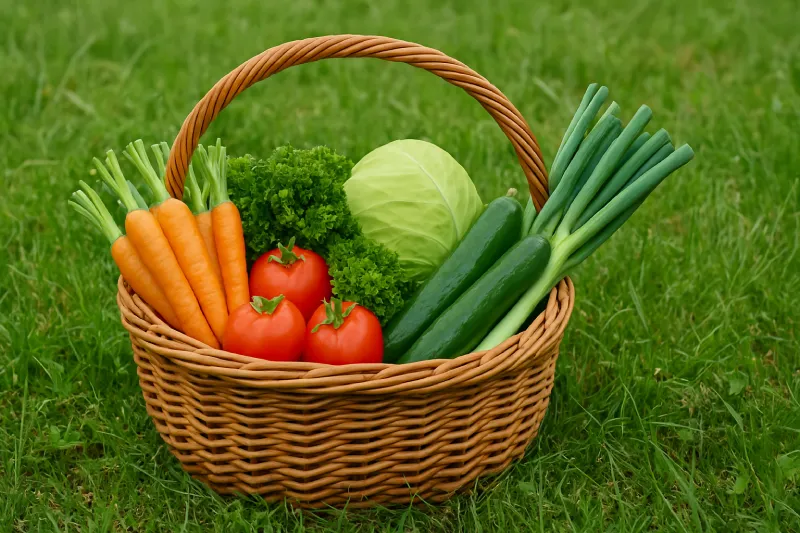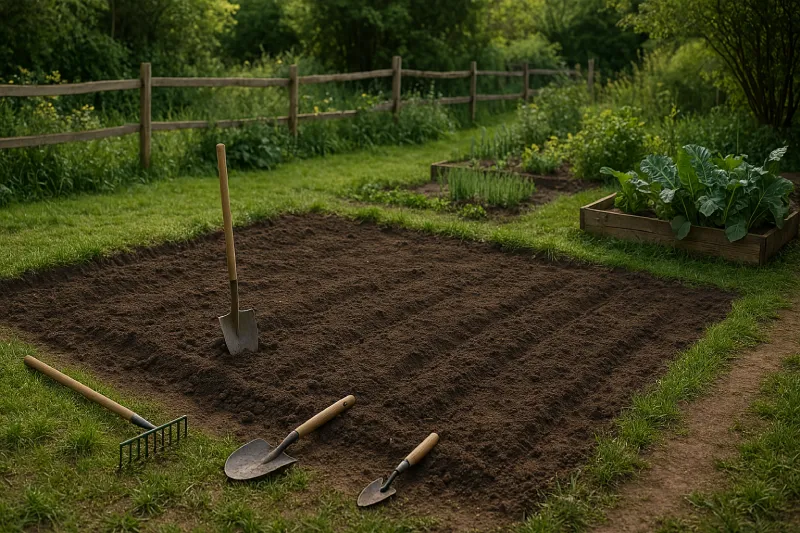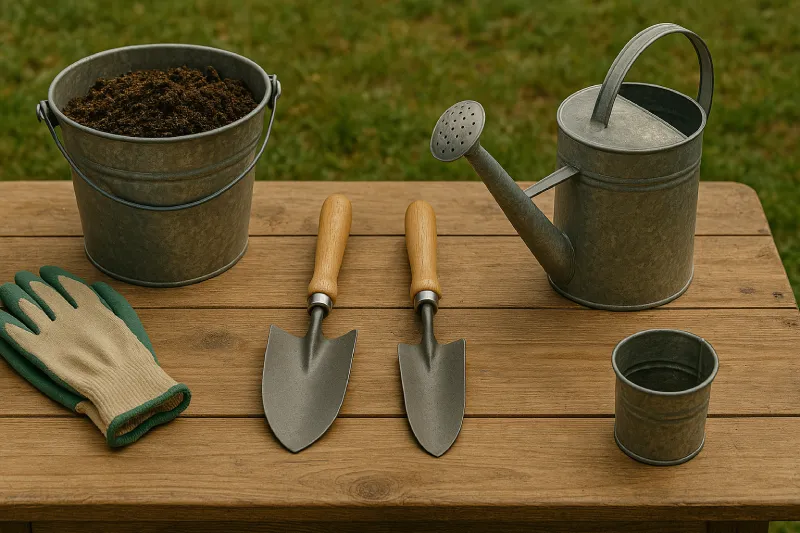
Beginner’s Guide to Easy Backyard Vegetable Gardening
A thriving home vegetable garden can be very rewarding. Fresh produce from your own yard is often tastier and more nutritious than store-bought veggies. Gardening also gets you outdoors for gentle exercise and provides a great sense of accomplishment . Many people find it relaxing to tend plants and watch them grow. With a bit of basic know-how, anyone – even a total novice – can successfully grow food in a temperate climate backyard. This friendly guide will walk you through the essentials to get started.
A Beginner's Guide
The Veggie Show
Why Vegetable Gardening is Rewarding
- Delicious, Fresh Produce: Homegrown vegetables have amazing flavor and texture. There’s nothing like picking a ripe tomato or crisp lettuce from your garden – the sweet, juicy taste will likely surpass anything from the supermarket. You’ll enjoy ultra-fresh, seasonal produce at its peak.
- Health and Satisfaction: Growing your own food can enhance your diet with more vitamins and nutrients. It also offers light exercise (all that digging and weeding) and a rewarding hobby. Gardeners often report lower stress and a happier mood from caring for plants and being in nature. It’s deeply gratifying to sow, tend, and harvest your own veggies.
- Budget-Friendly and Eco-Friendly: A packet of seeds is inexpensive and can yield many plants, potentially saving money on groceries. Plus, you’ll reduce the distance your food travels. Any surplus can be shared with friends or neighbors, building community.

Easy Vegetables
When beginning, it’s wise to choose reliable, low-maintenance vegetables. We recommend these easy options for novice gardeners.
- Lettuce: Fast-growing and forgiving. Leaf lettuces and salad greens can be sown in early spring or fall, and you’ll start harvesting tender leaves in just a few weeks. They prefer cooler weather and partial shade is okay. Simply snip outer leaves as needed for continuous salads.
- Radishes: One of the quickest crops – ready to harvest in about 3–4 weeks. Radishes grow best in the cool spring or fall. They require very little care: just scatter seeds in loose soil, keep them watered, and enjoy the crunchy roots (and even the green tops) in no time.
- Green Beans: Bush beans are an ideal beginner crop for summer. Plant the seeds after the last frost, and within two months you’ll have plenty of beans. They tolerate heat well and keep producing pods if you pick them regularly. Green beans don’t need much more than sun, water, and perhaps a simple stake for support.
- Tomatoes (especially Cherry Tomatoes): Tomatoes are incredibly popular and rewarding. For simplicity, start with a small nursery seedling (rather than seed). Cherry tomato varieties tend to be very productive and a bit easier to grow than large heirlooms. Plant after frost, give them plenty of sun, water, and some support (a stake or tomato cage), and you’ll be picking sweet tomatoes all summer.
- Zucchini (Summer Squash): Zucchini is famous for how prolifically it grows. A couple of zucchini plants can supply more squash than a family can eat! Sow seeds or transplant starters in late spring. They need decent space, sunshine, and regular watering, but little other effort. You’ll see yellow blossoms and then zucchini that seem to double in size overnight.
- Carrots: This root vegetable thrives in cooler weather of spring and fall. Carrots prefer loose, well-drained soil. Sow the seeds directly and keep the soil moist until they germinate (which can take 1–2 weeks). They may require a little thinning of seedlings to give roots space. After that, just wait ~2 months and pull up sweet, crunchy carrots.
- Beets: Easy to grow and fast maturing (around 2 months). Beets can be planted in spring or late summer. Like carrots, they need loose soil and even moisture. Both the round roots and the leafy greens are edible and packed with nutrients. They’re quite hardy in cool weather and don’t attract many pests, making them low-fuss.
- Leafy Greens (Spinach, Swiss Chard, or Kale): Greens are great for beginners. Spinach can be planted very early (it likes cool temperatures) and harvested within 40–50 days for tender leaves. Swiss chard and kale are a bit more heat-tolerant and will grow all season long, providing continuous greens to pick. These plants are resilient and will keep producing new leaves after you cut some, offering a long harvest window.
Basic Steps to Get Started
Starting a backyard vegetable garden is straightforward if you break it down into a few simple steps. Here are the basics for planning, preparing, and caring for your garden:
- Choose the Right Location: Pick a sunny spot for your garden – most veggies need at least 6 hours of direct sun per day (8+ hours is ideal). The area should drain well (avoid any spot where water puddles after rain, as soggy roots can rot). If possible, choose a location that’s convenient – near your house and a water source – so it’s easy to tend and water. Also, try to find a spot somewhat sheltered from strong winds, and not too close to big trees (which can cast shade and compete for nutrients). A location that meets these conditions will set your vegetables up for success.
- Prepare Your Soil: Good soil is the foundation of a healthy garden. First, clear the area of any weeds or grass. Loosen the soil to a depth of about 8-12 inches using a shovel or garden fork (this helps roots penetrate and improves drainage). Remove large rocks or debris as you go. Work in some organic matter – mixing in compost or well-rotted manure will enrich the soil with nutrients and improve its texture for plant roots. Rich, loose soil that doesn’t stay waterlogged will give your seedlings an easy medium to grow in. (If your native soil is very poor or compacted, you might consider using a raised bed with fresh garden soil, but this isn’t required.)
- Plan and Plant Wisely: Timing and spacing are key. Plan your planting for the appropriate season: some crops prefer cool weather (plant lettuce, peas, radishes in early spring or fall), while warm-season veggies (tomatoes, peppers, squash, beans) shouldn’t be planted until after the last frost date when the soil has warmed. Check your local frost dates so you know when it’s safe to plant tender plants outdoors. You can start with young transplants for crops like tomatoes and peppers (buying baby plants from a nursery) to make things easier, and sow seeds directly in the ground for others like beans, carrots, or lettuce. When planting, follow the spacing and depth recommendations on your seed packets or plant tags – giving each plant enough room will reduce upkeep and disease. Gently firm the soil around seeds or seedlings and water them in. With the right plants at the right time, your garden will take off strongly.)
- Water Consistently: Proper watering is one of the most important tasks for a thriving garden. Vegetables typically need about 1 inch of water per week (from rain and/or watering). Rather than light daily sprinkling, water deeply so moisture reaches down into the root zone – for example, you might water a few times per week if it doesn’t rain, adjusting to keep the soil evenly moist. Stick your finger an inch into the soil; if it feels dry, it’s time to water. It’s best to water in the morning so that foliage dries off by evening, which helps prevent fungal diseases. Aim the water at the base of the plants (a watering can with a rose attachment or a gentle hose nozzle works well) to avoid constantly wetting the leaves. Consistent, deep watering will encourage roots to grow strong and keep your plants happy.
- Stay on Top of Pests (and Weeds): A little prevention goes a long way. Check your garden each week for any signs of pests or disease – look at the undersides of leaves and new growth for holes, spots, or bugs. If you spot harmful insects like caterpillars or beetles, simply pick them off by hand (wear gloves if you squeamishly prefer) or spray them off with a burst of water. Keeping your garden tidy will also help – pull any weeds that sprout (weeds compete for water and can harbor pests) and remove dead or diseased plant debris. Whenever possible, avoid harsh chemical pesticides; you likely won’t need them in a small beginner garden. Instead, try natural remedies if an infestation occurs – for example, insecticidal soap or neem oil spray can control soft-bodied insects in an eco-friendly way. Planting some flowers and herbs can invite beneficial insects that prey on pests, and as mentioned, marigolds are known to repel certain bugs. For bigger critters like rabbits or deer, you may need to put up a simple fence or netting around your garden beds to keep them out. By monitoring your garden regularly and responding promptly, you’ll prevent small issues from becoming big problems.

Tips to Keep Gardening Simple and Enjoyable
Gardening should be a joy, not a source of stress. Here are some tips to simplify the process and fit gardening into a busy life, so you can have fun with it:
- Start Small and Simple: One of the most common mistakes for first-timers is planting too much. It’s better to be proud of a small garden than frustrated by a big one. Begin with a modest plot or even a few containers. Stick to a handful of easy vegetables at first. This keeps the work manageable and lets you build confidence. You can always expand in the future as you gain experience.
- Grow What You Love to Eat: Focus on vegetables (and herbs) that you actually enjoy and use often in the kitchen. If your family loves green beans or cherry tomatoes, grow those! But if no one likes eggplant, don’t bother with it. Planting what you like will keep you motivated and ensure your harvests get used (or shared). As experts say, if your kids adore carrots, put more effort into carrots – but skip the brussels sprouts if they won’t get eaten. Gardening is most rewarding when it feeds you with things you relish.
- Use Time-Savers: There are a few simple ways to reduce maintenance. Mulch your garden beds with straw, shredded leaves, or grass clippings to suppress weeds and help the soil retain moisture – meaning you’ll spend less time weeding and watering. Growing in a small raised bed can also cut down on weeding and bending over. If you have the option, consider a soaker hose or drip irrigation on a timer to automate watering. Group plants with similar water needs together. Working smarter will free up time and keep your garden low-effort.
- Make it a Routine, Not a Chore: Tie garden care into your regular schedule in a way that feels enjoyable. For example, you might spend 10–15 minutes each morning or a half hour on weekends checking plants, watering, and harvesting. Many gardeners find this routine relaxing – a chance to pause and connect with nature. In fact, maintaining a small garden often takes only about an hour a week once everything is established. By integrating those short sessions into your week, the work never piles up, and you’ll keep your garden in great shape without feeling overwhelmed. If you plan to be away on vacation, ask a friend or neighbor to water your plants (or focus on spring crops that will be done before your trip).
- Enjoy the Learning Process: Remember that gardening is a journey of learning by doing – and even seasoned gardeners have the occasional plant fail. Don’t be discouraged by a few yellow leaves or a crop that doesn’t thrive; each season you’ll discover what works best in your garden. Celebrate your successes (like that first ripe tomato or big basket of beans!) and don’t fret over minor setbacks. Involve your family or kids if you can – it can be fun and satisfying for everyone to watch the garden grow. Most of all, savor the time you spend outdoors. Gardening can be therapeutic and joyful, so keep it light-hearted. With realistic expectations and a positive mindset, you’ll find that growing your own food is deeply rewarding.
Essential Tools for Beginners
You don’t need a lot of fancy equipment to start a vegetable garden. A few basic tools and helpful resources will make the job easier:
- Gardening Gloves: A good pair of gloves will protect your hands from dirt, thorns, and splinters while digging or weeding. They’ll keep your hands clean and blister-free, making your gardening experience more comfortable.
- Trowel and Spade: A hand trowel is like a small shovel – perfect for digging small holes for planting, transplanting seedlings, or scooping soil. A larger spade or shovel is useful for initial bed preparation, like turning over soil and mixing in compost. These tools help you work the soil efficiently.
- Watering Can or Hose: Consistent watering is key, so have a convenient way to water your garden. A watering can with a rose (sprinkling head) is great for gently watering seedlings and containers. For larger gardens, a garden hose with a spray nozzle or wand will help you reach all areas. Consider a hose timer or drip irrigation for automatic watering if you have a busy schedule.
- Supporting Stakes or Trellis: Some plants may need a little structural support. For example, tomatoes often grow tall and heavy with fruit – a simple stake or tomato cage will keep them upright. Climbing peas or pole beans will appreciate a short trellis, and vining cucumbers can be trained up a support. Having a few stakes, garden ties, or trellis sections on hand will help keep your plants tidy and healthy.
- Quality Soil and Compost: While not a tool per se, having good soil is crucial. Keep a bag of compost or organic all-purpose fertilizer around. Mixing compost into your soil at planting time and periodically as a top-dress will feed your veggies naturally. Healthy soil full of nutrients and microbes means less work fighting plant problems later.
- Veggie Stats: Keeping track of all the different sowing schedules, watering and fertilization needs and other tasks can become overwhelming, this is where Veggie Stats comes in. Take away the mental burden of keeping track and manage your garden with Veggie Stats, this way you can focus on what matters.

